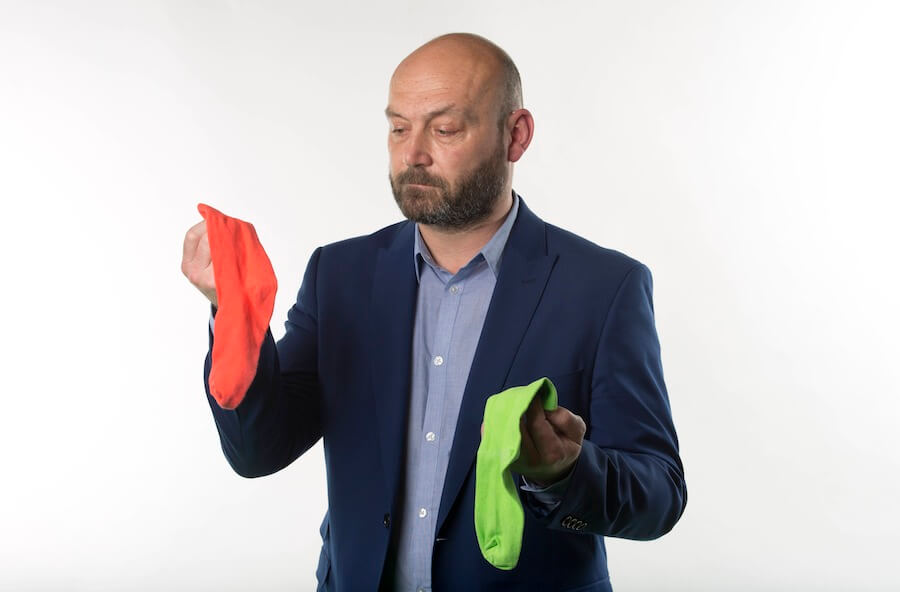Missing socks were once the bane of most people’s lives. Until now, that is.
U.K. scientists are claiming to have unraveled the mystery of why socksgo missing. Psychologist Dr. Simon Moore and statistician Dr. Geoff Ellis have developed a formula,known as the Sock Loss Index,to predict the likelihood of socks going astray. The theorem includes factors such as volume of laundry, amount of socks being washed, number of people in the householdand even a washing type. The research was commissioned by Samsung to mark the launch of its new AddWash machine, which allows users to add items to its drum mid-way through a wash. Moore explains to Metro why socks cause such frustration.
Why did you decide to look into the mystery of missing socks?
Missing socks are one of life’s unexplained mysteries. It makes for a great talking point because it is something we can all relate to. And as a psychologist, I can apply my knowledge of human behavior to explain these kind of situations and experiences. We wanted to discover factors that affect sock loss and then work with a statistician to provide a probability formula so people can work out their own propensity for sock loss. RELATED:Mother’s Day gift picks
How did you come up with the formula?
We used a combined scientific method of interviews and psychologically-driven surveys to discover the behavioral repertoires of washing routines in over 2,000 households in the U.K.
What are the most interesting and amazing results?
The fact that there is a large psychological element to sock loss.The main predictors of losing socks are divided into reasons: lack of attention to detail, lack of effort combined with the complexity of the wash routineand psychological factors. What are these psychological elements?
The greater number of people in the household or who does the washing, the greater the chance that we think ‘someone else is responsible for that’.
If we cannot see that a sock has separated from its pairing, then we do not consciously think about it or become alerted to it. In other words, if we see an odd sock at the top of the dirty washing pile, we instinctively search for its match. If we do not see any evidence that we have not collected up all the appropriate socks to be washed, we believe that we have been effective in ensuring all the socks are together.
Are there any other elements involved?
Yes.For example, an error of commission. When a person responds or does something that they should not do, such as by putting a lone colored sock in the white wash, accidentally kicking a sock under a wardrobeor placing a sock precariously on a radiator to dry, which subsequently falls behind etc. And finally, a person’s attitude to doing the laundry. The more positive we are to doing the washing, the more likely we will take more care and pay more attention to doing it properly. The less positive we are, the more we cut corners, put less effort in and just get it over with – which of course results in a lower level of attention and a greater number of errors. RELATED:Arianna Huffington wants you to take a nap What are the other discoveries that you’ve made?
Colored socks are more than three times likely to go missing than any other type (white, stripy, spotty etc.).
In the U.K., those living in the northeast have the most positive attitude to ‘laundry washing’, while those living in the southeast have the least. The southeast has the greatest scores for the ‘Practical Care’ of their pre-wash laundry (emptying pockets, unrolling socks and sleeves, turning clothes the right way around, etc.) than any other region. The northeast has the greatest ‘wash size’ (comprised of the number of people in the household multiplied by the frequency of doing a wash) than any other region. What does Samsung’s AddWash have to offer?
It uses an innovative second door which allows users to simply drop in extra items during the wash cycle. Perhaps this will provide a possible end to the problem of forfeited footwear.
What impact could your study have?
It might help people keep sock loss to a minimum. If they pay more attention to the details, it reduces the chance of buying more socks over their lifetime.
What’s next?
At the moment we are digesting these results. It might be interesting to investigate people’s attitudes to their clothes in general and in terms of how this impacts their emotional connection to clothing. – By Dmitry Belyaev
The mystery behind missing socks has been solved

Metro World News















